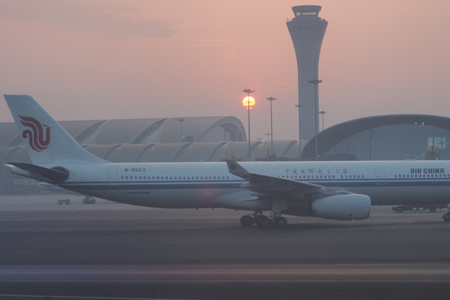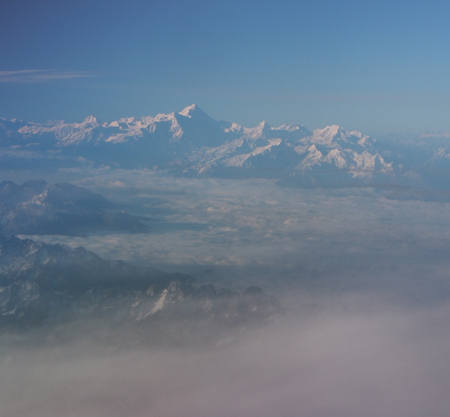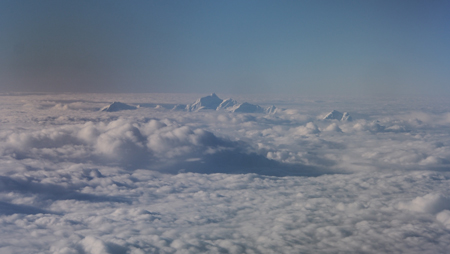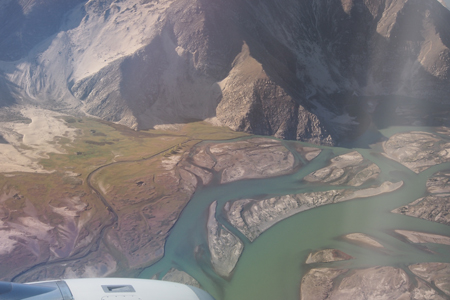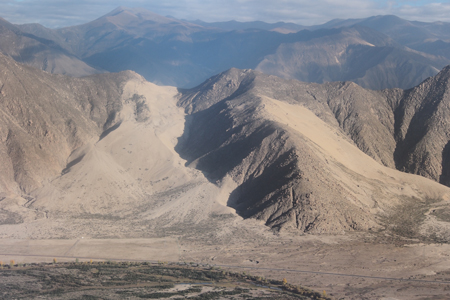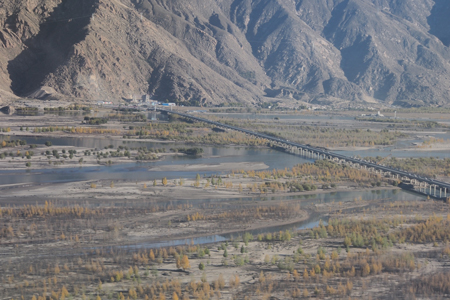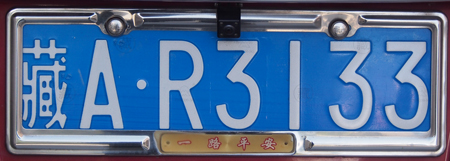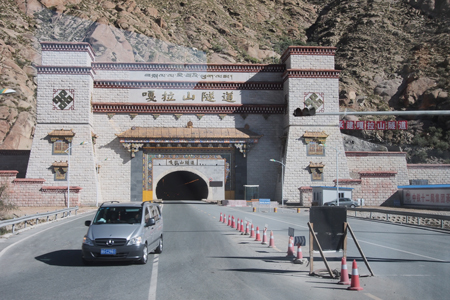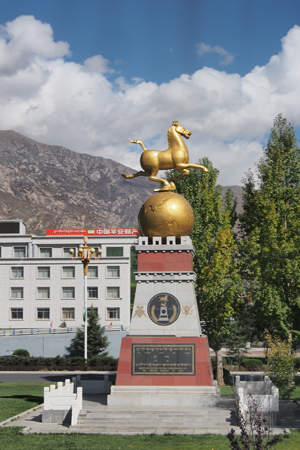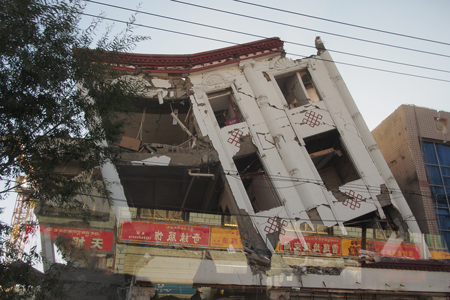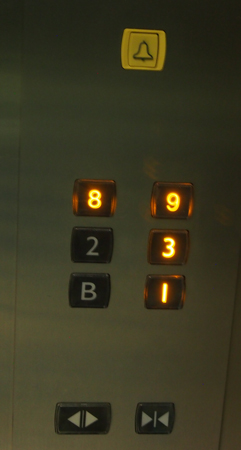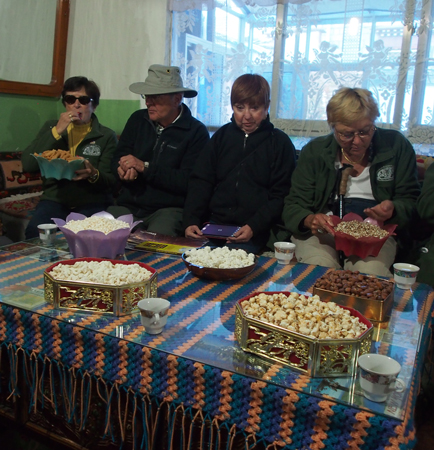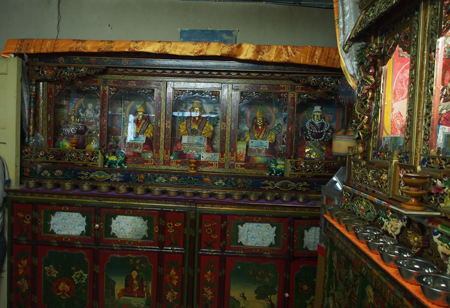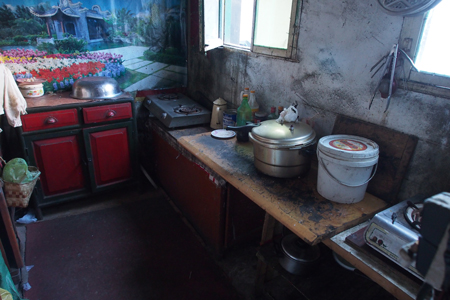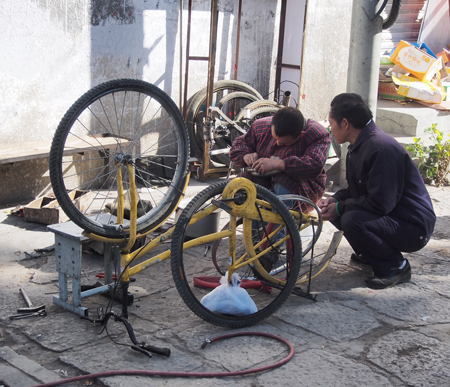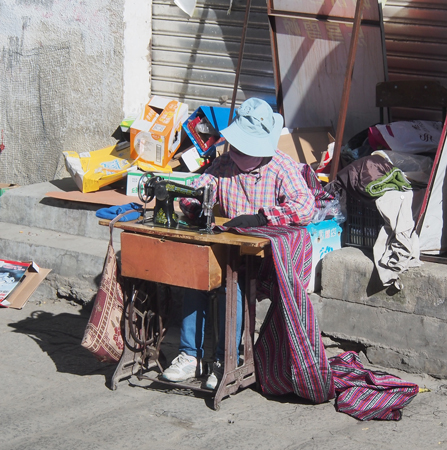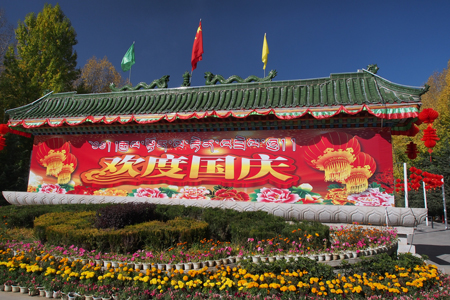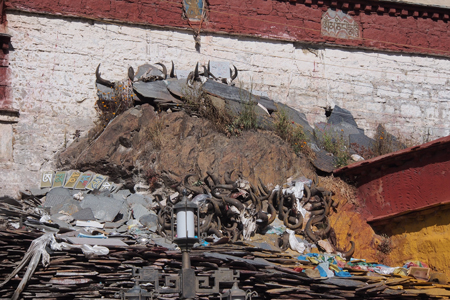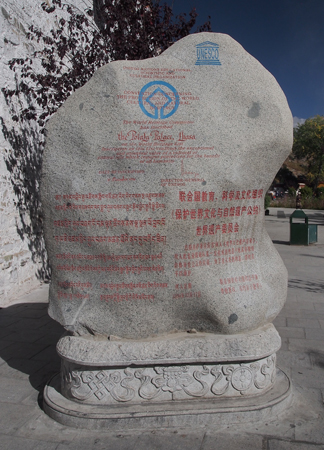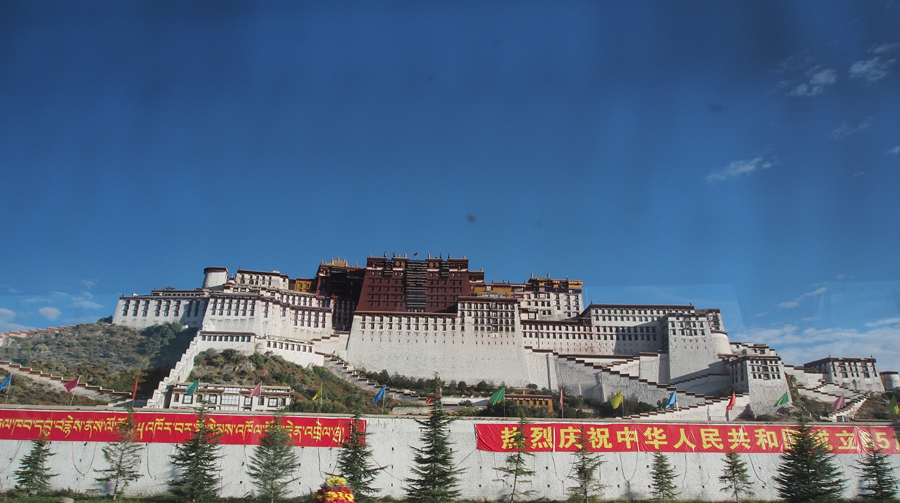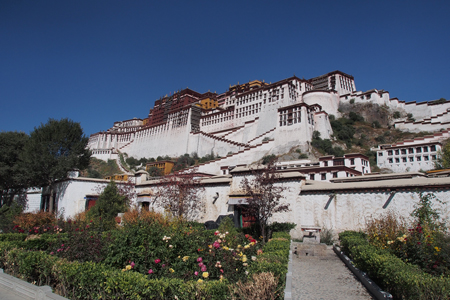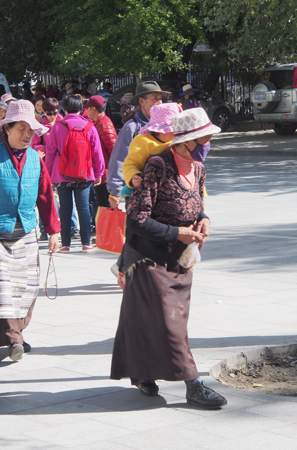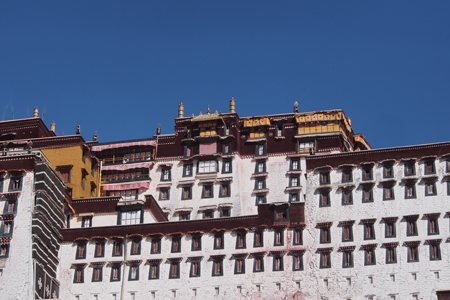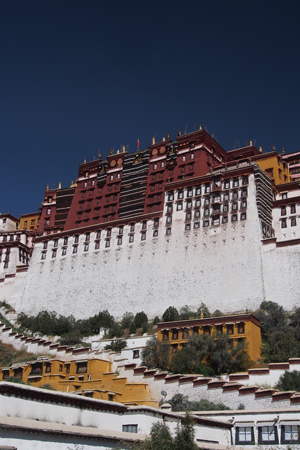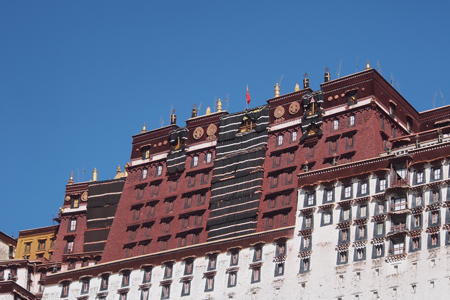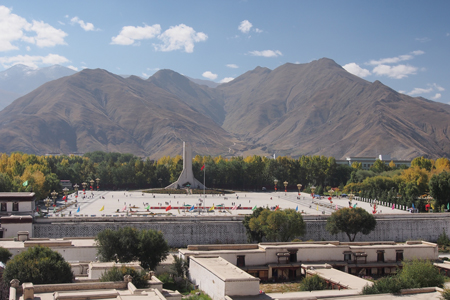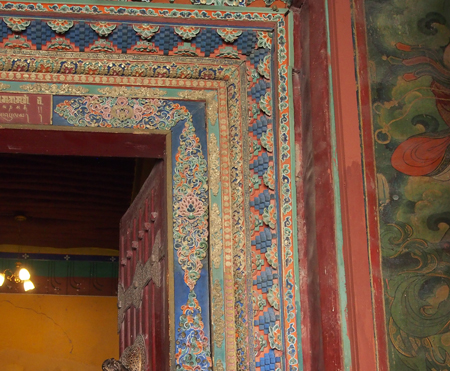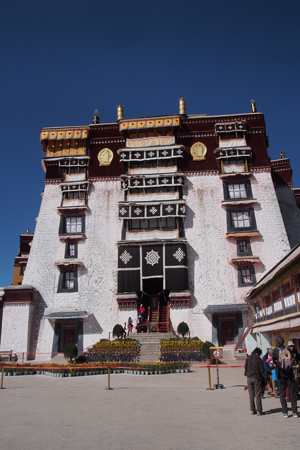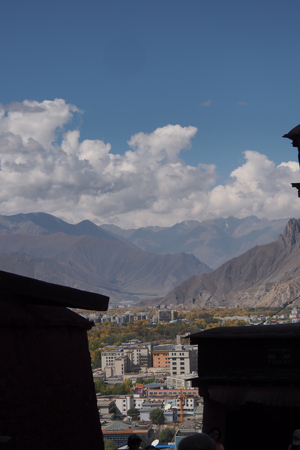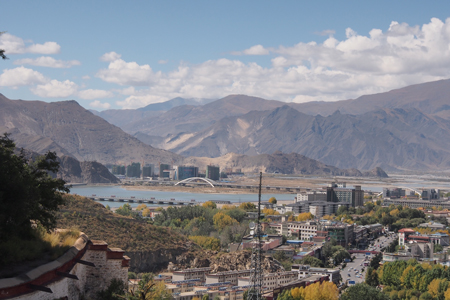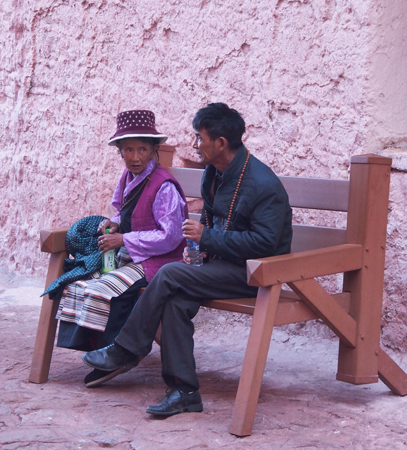Tues., 10/7/14 – Chengdu to Lhasa, Tibet
We were up early (Marge took a shower at 3:50 AM) and met in the hotel lobby at 4:50 AM. The hotel box breakfast was terrible. Only the hard-boiled egg and banana were edible.
We were very happy to arrive in Lhasa, Tibet at 9:15 AM and see our bags appear on the carousel. We gave our passports back to Michael so he could get our group through the security check point entering the new city of Lhasa and to get us checked into our hotel in the old city. The Chinese have a tight hold on Tibet. The airport is shared with the Chinese Air Force and about 20 fighter planes were lined up beside the runway. We will see army men with AK47s here and there around the city.
Breakfast on the two-hour plane ride was also interesting. I ate the Congee (rice porridge). It tasted like rice pudding without any sugar but it was better than the chopped carrots with a black 100-year-old egg! They did have coffee that wasn’t too bad and we ate more granola bars from home.
The flight was smooth and as soon as we were out of Chengdu we started seeing snow capped mountains rising above the clouds. The mountains look beautiful but very uninhabitable.
Sunrise over Chengdu
Southern Himalayas - about 350 miles south of Mount Everest
Southern Himalayas
Southern Himalayas
Approaching Lhasa
Brahmaputra River
Welcome sign - from the bus - note the phrasing "China Tibet"
In Lhasa we met our next local guide, Yangki. She is a native Tibetan and welcomed us each with a white Kadak scarf. On the ride into Lhasa – the airport is 40 miles from the city– she talked about our visit. Lhasa is the capital city of Tibet. It has about ½ million people. The city is surrounded by the Himalaya Mountains and the Kyi River (or Lhasa River) runs through it. The air contains 68% of the oxygen compared to sea level. The road we travelled on was built in 2005 and went through a tunnel 2 km long. The Chinese claim that Lhasa is the highest city in the world at 12,000 feet (Wikipedia lists several that are higher and larger) and the railroad and the Lhasa RR station are the highest in the world. (Everyone has to have the highest this, or the biggest that, or the smallest, etc. – such nonsense!) The RR opened this year and cut the travel time from Beijing to 42 hours. The train is called the Train to Heaven – fortunately, we flew.
We drove through a valley along the Brahmaputra River (see link above). The mountains are rocky and many minerals are mined in them. The fields grow barley, wheat, and canola (rape seed). They use a lot of barley - to feed yak and cows in the winter, as well as in many Tibetan dishes. Samba is a barley dish we will eat and Chhaang, a local brew made with barley (Lhasa Beer is the only Tibetan beer sold on the world market).
We saw several areas full of prayer flags. The blue is for the sky, white = clouds, red = fire, green = water, and yellow = earth. Each flag has a Buddhist saying and they are put where the wind will blow their prayers to the gods. 95% of Tibetans are practicing Buddhists. We saw many people in town walking with prayer beads in their left hand and spinning a prayer wheel (clockwise) in their right hand. Inside the spinning wheel is a roll of paper with Buddhist sayings on it. Lhasa is a city of pilgrimage because of the Potala Palace here. It was the summer palace of the Dalai Lama.
Yangki also tried to teach us some Tibetan words. Yogi Bear’s “Yaba daba do” is a Tibetan phrase that means very, very good! It is a Tibetan word and one I can remember. “Tashidelek” is hello or good luck and can be accompanied with hand signals or sticking out your tongue!
Tibetan flag (obviously no longer used)
Chinese license plate of Tibet
Lots of tunnels
Monument
Leaning building of Lhasa
Interesting elevator panel - the Chinese are so superstitious they don't use certain numbers (lots of them) to designate floors but just skip to the next acceptable number
Wed, 10/8/14 – Lhasa, Tibet
Today's touring did not start until 9:30 AM, which gave our sea level people more time to adjust to 12,000 feet. Our first stop was another home-hosted experience. Our hostess today was a middle class tailor and seamstress. Her home was very third world but decorated with tapestries, woven covers on the couch, and elaborate religious shrines. We sat in her reception room and had yak butter tea and traditional snacks: popped rice, barley, and corn; sugar coated peanuts; dry yak cheese curds; beans, and several other things. We sampled most of them to be polite. Yangki showed us Tsamba or barley powder that they mix in tea or yak milk and eat as porridge. She showed us the butter churn they use to make the yak butter. On the wall was a large picture of the current Pachen Lama, the highest ranking lama living in Tibet. She sews using a treadle sewing machine.
Prayer flags
Snacks
Shrine
Kitchen
Bicycle repair shop
At 11:40 we had our controlled visit to the Potala Palace. We had tickets issued by the Chinese government with our passport numbers on them and had to show the ticket and passport to get into the security screening to enter the Dalai Lama’s winter palace.
When outside, most of the women in Lhasa cover their faces not because of the pollution, but to protect their skin from the intense rays of the sun.
Entrance to the Potala Palace grounds
Sacrifice area
Sign post
UNESCO World Heritage site
Potala Palace
Potala Palace
Potala Palace
Tibetans on their daily prayer walks
Potala Palace
Potala Palace
Potala Palace
Potala Palace
In the 7th c., the 5th Dalai Lama chose this hill to build his palace on because it looked like a sleeping elephant. The palace is huge. The white section was his residence and political place, the red section was the religious area, and the yellow painted section houses the rooms of the current Dalai Lama, who is, of course, in exile. There are 1,000 rooms and 360 steps to get up to the rooms. The palace became a UNESCO Heritage site in 1994. The white of the building represents the Compassionate Buddha; the red represents wisdom; and the black around the doors and windows, protection. The hill opposite was the Holy or Medicine Hill where a school teaching about medical herbs once stood. It was razed during the Cultural Revolution and now has a TV tower on the top.
View from the Palace steps (as one pauses for breath on the way up)
Detail of a doorway
View from the Potala Palace
View from the Potala Palace
View from the Potala Palace
Tibetans in traditional costume
Walking down after the Palace visit
On the daily prayer walk
Fifty years ago there were 12,000 Buddhist monks in Tibet. Today there are about 4,700 registered monks. Since China has compulsory education for nine years starting at age 7, the government controls how many boys can enter a monastery at age 7 instead of going to public school. Buddhism is slowly declining here. Farmers and nomads and private sector workers can practice the religion, but all government employees, like our university professor lecturer, will lose their jobs if they participate in Buddhist ceremonies or festivals during work hours. Since 2008, the Chinese Air Force has fighter planes at the airport and infantry around the city in case “India decides to invade” (A Chinese communist cover story.)
| Return to Top | Return to Itinerary | Return to Trips page to view other trips | Return to Dreamcatcher Home Page |
